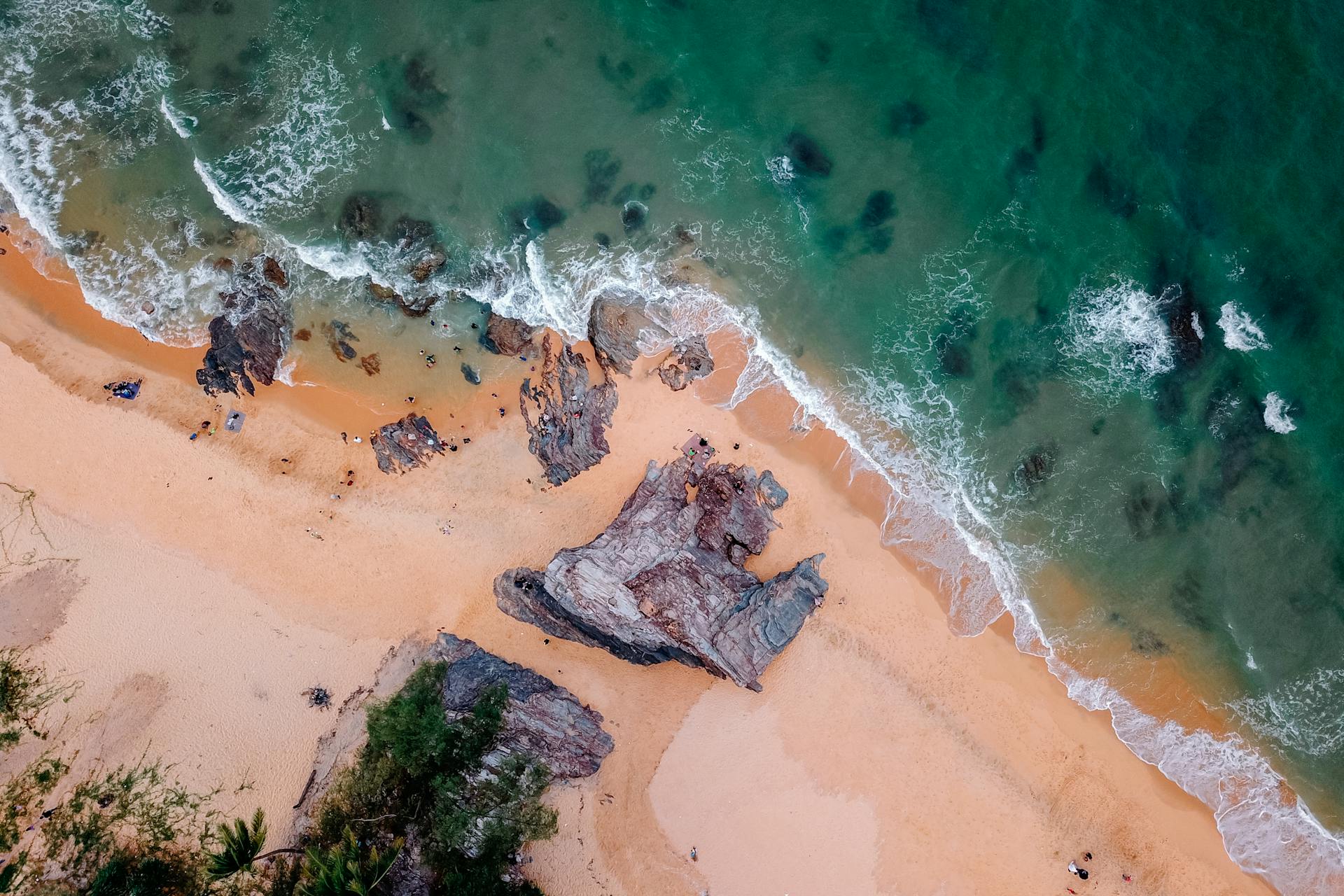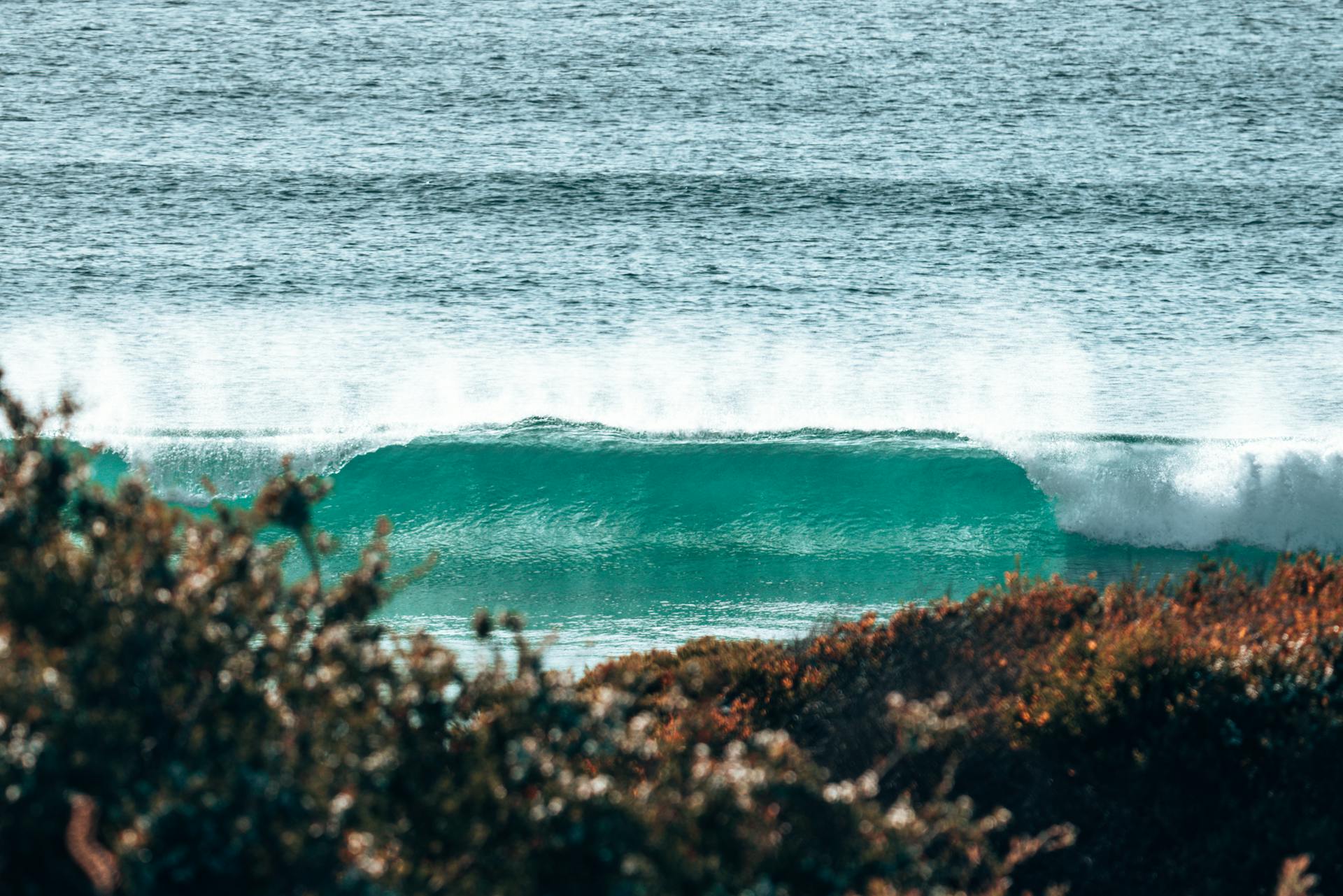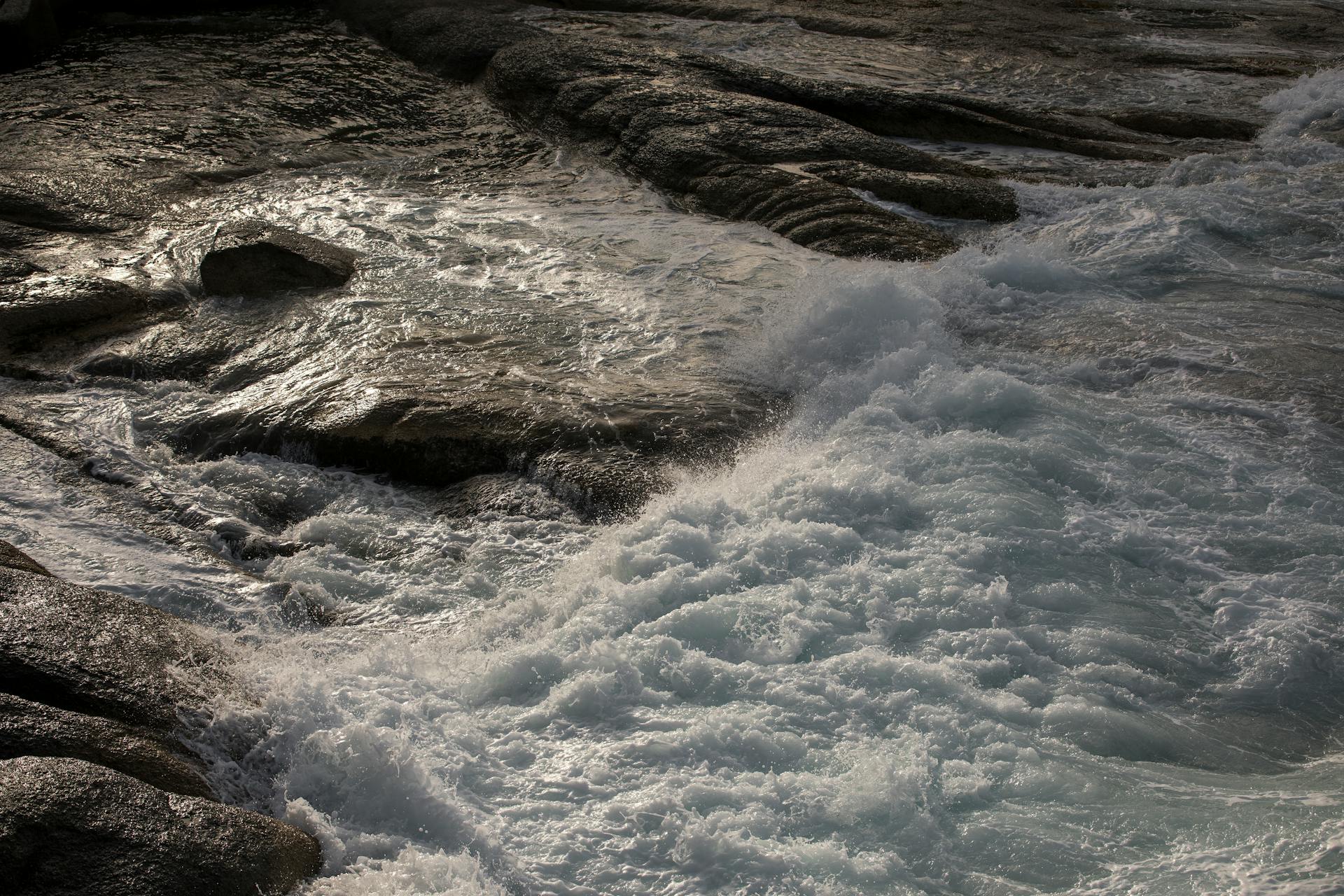
Shore power is a system that allows boats to plug into a power source on land, eliminating the need for generators. This technology has been around for decades, but it's gaining popularity as more marinas and ports install shore power systems.
One of the main benefits of shore power is that it reduces greenhouse gas emissions and air pollution. By not having to run generators, boats produce fewer emissions and create a cleaner environment for everyone.
Shore power systems are designed to be safe and efficient, with built-in protections to prevent electrical shock or fires. These systems are also designed to be easy to use, with clear instructions and minimal maintenance required.
What Is Shore Power?
Shore power is a system that allows boats to connect to a power source on land, eliminating the need for generators.
This system uses a specialized cord to connect to a shore power inlet, which is typically found on a dock or marina.
The shore power cord has a plug that fits into the inlet, allowing the boat to draw power from the land-based system.
Shore power systems come in different types, including 30-amp and 50-amp systems, which provide varying levels of power to the boat.
Benefits of
Shore power provides a wide range of benefits, not only for end users but for the environment and the vehicles themselves. The most well-known benefit is the reduction of emissions being released into the environment. Cruise ships can reduce diesel emissions by 80% and CO2 emissions by 66% with shore power.
The reduction of emissions also has a significant impact on the health of port workers and citizens living near these ports. Less emissions in the air means less risk of cardiovascular and respiratory issues and cancer in anyone exposed to said emissions. In the case of Brooklyn Cruise Terminal, this has an expected monetized health benefit of $9 million per year.
Shore power can also help extend the life of an engine. Since shore power eliminates the need to idle an engine, any time spent connected to shore power presents a reduction in wear and tear on the engine. This is especially important for engines, which are one of the most expensive systems to repair or replace in a vehicle.
Streamlining operations is another benefit of shore power systems. They provide a reliable source of electricity to docked vessels, allowing marina operators to ensure uninterrupted access to electricity. This access facilitates smoother day-to-day operations at the marina.
Shore power also offers a sustainable alternative to onboard generators. By embracing shore power, marinas can reduce greenhouse gas emissions and noise pollution. This contributes to cleaner air and water in and around marinas.
Safety Considerations
Using shore power is a convenient way to keep your boat or RV powered up, but it's essential to be aware of the safety considerations involved.
Shore power can pose risks to your boat and crew if not used properly.
Always use the cord that comes with your RV or a quality extension cord that's grounded to avoid damaging your electrical system.
Using a power pedestal is a safe and convenient option that uses AC electrical plugs to run your AC-dependent appliances directly or charge your 12V DC battery.
Just remember to use shore power responsibly and follow the necessary safety precautions to ensure a safe and enjoyable experience.
Connections and Plugs
Connecting your boat to shore power is a straightforward process. You'll need a shore power cable or power cord that matches your boat's electrical system and the dock's power source.
The most common shore power connection for small to mid-sized boats is a 30-amp plug, which has three prongs and supplies 120V AC power. This type of plug can power basic systems like lights, fans, battery chargers, and small appliances.
Boats up to 35 feet in length typically use a 30-amp connection. A 30-amp plug can provide a max power of 3,600 watts, making it suitable for most small to mid-sized boats.
Some boats may require a dual 30-amp plug to create a 240V service. This type of setup is ideal for boats that need more power but don't require the full 50-amp service.
Here are some key facts about shore power connections:
Your RV's battery will receive a charge while plugged in, thanks to a built-in converter that converts AC electricity into DC. This means your 12V battery will stay topped up, even when you're using AC appliances.
Connections Available

IEC 62613-1 and IEC 62613-2 are two standards that apply to equipment suppliers who provide a comprehensive overview of sockets and plugs.
These standards ensure that the shore power connections available are safe and reliable.
A power pedestal is a quick and convenient option that uses AC electrical plugs to run your AC-dependent appliances directly or charge your 12V DC battery.
For larger vessels, a 50-amp shore power system provides much more power, especially if you need to have auxiliary engines or run multiple high-demand appliances like air conditioning, heaters, or galley equipment.
50-amp plugs often provide both 120V and 240V service, making them versatile for boats with more complex electrical needs.
Here are some key facts about 50-amp plugs:
- Voltage: 240V or 120V (split-phase)
- Common Use: Larger boats and yachts
- Connector Type: NEMA SS-2 or NEMA L14-50
- Max Power: 12,000 watts
Dual 30-Amp Plugs
Dual 30-Amp Plugs are a great option for boats that require more power than a single 30-amp circuit can provide.
You'll need to use two 30-amp plugs combined to create a 240V service, which is perfect for boats that need a bit more juice.
To use dual 30-amp plugs, you'll need a special adapter to split the load between two 30-amp pedestals.
This setup is ideal for boats that don't need the full 50-amp service, but still require more power than a single 30-amp circuit can provide.
Here's a quick rundown of the key specs for dual 30-amp plugs:
- Voltage: 240V (by combining two 30-amp circuits)
- Common Use: Boats that require more power than a single 30-amp circuit can provide but don’t need the full 50-amp service.
With dual 30-amp plugs, you'll have the power you need to run your boat's systems, without breaking the bank on a full 50-amp setup.
Electrical Distribution and Management
Shore power is a vital component of electrical distribution and management on boats. It provides a safe and efficient way to power electrical systems while in port.
Shore power systems typically consist of a 120-volt or 240-volt electrical connection that matches the boat's electrical system. This connection is usually made through a shore power cord that plugs into a dockside outlet.
Having a reliable shore power system is crucial for managing electrical demands on board. This is especially true for boats with large electrical systems, such as those with air conditioning, generators, and other high-power appliances.
How Does It Work, and Is It Universal?
Shore power operates by connecting dockside electrical outlets to vessels via power cords, allowing them to use electricity while docked. Most modern boats can handle shore power, but compatibility is key.
Boat owners need to ensure their vessels can safely connect to shore power. This involves checking the boat's electrical system and following safety guidelines outlined by marine electrical standards.
The process of connecting to shore power is relatively straightforward, but it's essential to get it right to avoid any issues.
Electrical Distribution
Shore power feeds into your boat's electrical panel, which is the central hub for distributing power to its systems.
The electrical panel is responsible for directing power to essential systems like lighting, refrigeration, and air conditioning.
Moisture and corrosion can be major concerns in harsh marine environments, which can complicate the distribution of shore power.
In these environments, fluctuating power demands can also cause issues with electrical distribution.
This is why understanding the nuances of shore power is crucial for safe and efficient use.
Upgrade Your Cord

Upgrading your shore power cord can make a big difference in how efficiently and safely your boat uses shore power. Most modern boats can handle shore power, but boat owners need to ensure compatibility.
In harsh marine environments, moisture, corrosion, and fluctuating power demands can complicate things. Upgrading to a thicker, better-insulated shore power cord can help reduce voltage drops and provide a more stable power supply.
If you're dealing with power fluctuations or inefficiencies, consider upgrading to a thicker, better-insulated shore power cord. This can help reduce voltage drops and provide a more stable power supply.
Invest in a Pedestal
Investing in a pedestal is crucial for any shore power system. A reliable and durable power pedestal is essential for securing outlets and circuit breakers.
These pedestals often come with additional features like water hookups.
Secure outlets and circuit breakers are must-haves for any pedestal.
Eaton power pedestals are a top-quality option that meets all marine standards. Haven Dock & Marine carries a full line of Eaton power pedestals with attractive designs and durable construction.
The Hatteras model is conservatively-sized for small spaces, while the Lighthouse pedestal offers all the bells and whistles.
Cable Management System
A cable management system is used to achieve a safe and organized connection of ships to the shore power supply.
Different types of ships and quay situations require specific cable management systems to be selected.
In some cases, the cable management system is located on board the ship, where only a connection box is needed on the quay.
Regulations and Providers
Starting from 2023, there are bans on the use of generators in various ports.
Shipowners must consider many safety regulations, which can be overwhelming.
In addition to these bans, there are safety regulations that shipowners must consider, which can be a challenge to navigate.
Regulations Regarding
Starting from 2023, there are bans on the use of generators in various ports.
Shipowners must consider many safety regulations, including those related to shore power.
There are regulations regarding shore power, which are becoming increasingly important as ports implement bans on generator use.
These regulations aim to improve safety and reduce environmental impact.
Who Provides?

Quay owners who have a shore power facility provide the shore power themselves. Suppliers of shore power systems for the quay and the ship include companies like Cavotec and Shore-Link.
Pon Power can provide the energy solution for your shore power facility when the grid connection is insufficient.
When Is Mandatory?
For inland vessels, shore power is mandatory when they're docked at a location with a shore power cabinet available.
Inland vessels have a clear requirement, but ocean-going vessels don't yet have an obligation to use shore power.
The goal is ambitious, with a target of 90% of Ro-Ro, passenger ships, and container ships using shore power in port by 2030.
Cost and Availability
The cost of using shore power can be a bit unpredictable, as it fluctuates with energy prices.
Investments may be needed to make a ship ready for shore power, which can vary depending on the modifications required.
The cost can be a significant factor in deciding whether to use shore power, especially for ships that don't need it immediately.
In some cases, the cost of shore power may be comparable to or even lower than the cost of running on diesel or other fuels, especially in areas with high energy prices.
Overall, understanding the cost and availability of shore power is crucial for making informed decisions about its use.
Frequently Asked Questions
What is the difference between 30 amp and 50 amp shore power?
A 30-amp RV connection handles 3,600 watts, while a 50-amp connection manages up to 12,000 watts, making it ideal for larger RVs and power-hungry appliances. The key difference lies in the voltage and amperage, with 50-amp connections providing twice the power of 30-amp connections.
Sources
- https://toolbox.igus.com/4652/what-is-shore-power
- https://havendock.com/blogs/tips/marine-shore-power-basics-a-boaters-guide
- https://www.dockboxes.com/blog/shore-power/5-benefits-of-shore-power/
- https://blog.ecoflow.com/us/what-is-rv-shore-power/
- https://www.containerspreaders.com/glossary/shore-power/
- https://www.pon-cat.com/en-nl/products/cat-power-generation/shore-power
Featured Images: pexels.com
